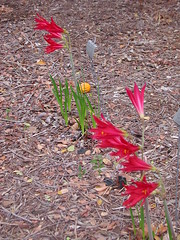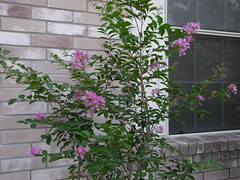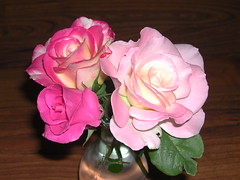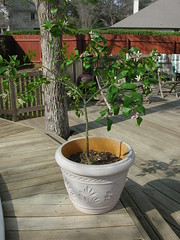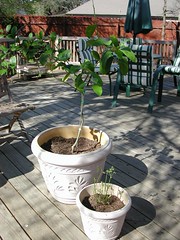Wednesday, December 20, 2006
Narcissus sprouted; crapes dormant
Weird December weather's taken a toll on the spinach and pansies -- alternating from light, wet freezes to 70s and dry has left them spindly. TV folk are actually forecasting snow for Christmas, so if that comes true it's back in the garage for them!
Trying also to keep several holiday rosemary topiaries healthy. Overwatering has turned some parts black, but I've been good about getting them lots of daylight.
In the past week the baby crapes have dropped all their leaves and in the grand tradition of my family I am completely convinced they are dead.
After two years of experiments (results recorded here) we are ready to commit to bedding plants for the back bed. I'll design a watering system and sketch a plan with the following solid performers: dwarf purple ruellia; rosemary officinalis; Grand Primo.
The plan is to have a few rosebushes along the back (because I love them, not because they do well); then a belt of rosemary for scent, vigor and permanent greenery; then edge the bed with ruellia. Between the lines of rosemary and ruellia I plan to tuck the Grand Primo and whichever bulbs I like to experiment with. That way there will be green most of the year (ruellia is green right now, for example -- I think it croaks in the heat) and it won't look as odd when the bulbs pop up or die back.
Friday, October 06, 2006
Sept. 24: Planted spinach and pansies
Start the pansy clock: They were blooming when I bought them and haven't stopped since. Last year, they bloomed right through until May. If they manage the same this year, that'll be six solid months of blooms. Which is enough to put them in the ground and leave 'em there, if you ask me. (Not saying that they'd survive the summer, just that they'd be worth replanting each year for that kind of performance. Plus I love their little faces.)
Thursday, September 28, 2006
Oxblood lilies bloom!
So, they went dormant (as in appearing totally dead) in mid-June and have bloomed two years now in mid-late September. Since we were out of town last year when they bloomed, I can't tell if they're spreading, but we are just glad to see them! (Jason called me at work and said "Hey, your red trumpets are out!")
Thursday, July 13, 2006
Wednesday, July 05, 2006
First crape blooms! Ruellias too
The flower is apparently lavender in appearance and looks nice with our grey brick. All have put on new growth recently in response to lots of rain/watering every couple of days via the Rose Hose. (Instructions said to water them once a week, but we found they were getting extremely droopy -- hence the naming -- so stepped up to every couple of days.)
In sum, we are delighted because we feared we might have killed 'em, and were fairly certain we would not get blooms this year.
The ruellias are covered with purple blooms (I've been watering them a lot too). And the roses all have new growth and buds, apparently disease-free. Saw the first rose from Mr. Lincoln on July 4, appropriately enough!
Monday, June 26, 2006
Oxblood dormant; daylilies still blooming
Replanted front flowerpots with vincas, doing OK so far. Pansies had completely dried up.
Copper soap fungicide (or dumb luck) is doing wonders for the roses. No sign of black spot or powdery mildew.
Daylilies still blooming, only a couple at a time, but really fantastic colors.
Sunday, June 18, 2006
Rose Hose: Operational!!
But my roses supposes erroneously!
What a wonderful feeling, after two years with my crummy first attempt -- then, this weekend, two 96-degree afternoons of hauling, digging, cussing, connecting, getting sprayed and cussing -- to do this...
....Simply stroll into my backyard, turn on the tap, and watch little burblers soak the feet of all 11 of my favorite rosebushes.
Oh, the luxury! I am going to take to this like the first time I had a washing machine of my own. No more hauling jugs of water out there -- I can just come home and water them all with one flick of the wrist!
The total project cost was about $20. (Well, the total cost for the Rose Hose that worked.) Rose Hose Mark 1 was about 50 feet of tiny vinyl tubing, and it was piggybacked off the existing flowerbed's minisprinklers. My thought was, that system is already there, and it's all tiny vinyl tubing, so that must work, right? Well, somewhere between splicing the systems and doubling the length of the tubing, hardly any water actually made it out to the roses. By that time, though, I had unwisely already trenched and buried the 50 feet of tube. So I left it there for two years, testing it occasionally, hauling gallon jugs of water out to the roses and plotting my revenge.
Lesson 1. Do not bury the system until you have tested it!
Rose Hose Mark 2 is about 80 feet of 1/2-inch stiff black poly tubing, connected directly to the tap (well, a manifold on the tap). Only two segments need to be buried because we've decided to put a bed along the fence (so we'll just put mulch over the pipe). It even extends to the climbing roses on the back fence! However, because the pipe is so stiff, it was a b*&%$-kitty to get into place -- every place it has to curve more than about 15 degrees (under the metal border, under the fence, up to the faucet) I either had to grade the earth to accommodate it or make some other adjustment. It kept bending almost to breaking point, and I'm lucky it still holds water. Not a forgiving product. I cursed a LOT. The next time, I would definitely use cheap garden hose instead, though the cost is probably $25 vs. $11.
Lesson 2. Investigate how many curves you will need to make, not just how many connections, before buying your materials.
All of the various bits I'm using come from
Mister LandscaperAnyway, it is good for my heart to see the little guys getting a really adequate amount of water through those drippers. I hope this will hold them through the hot three months to come. They have responded extremely well to the copper soap fungicide, showing little sign of powdery mildew or black spot at the moment, and they are leafing out afresh even now, bless their bippies. Just think what they will do with solid watering!
Sunday, May 28, 2006
Daylilies blooming; pansies pretty much toast
Foliage on the jonquils is starting to die, about the same time as last year.
The pansies in flowerpots out front are miraculously still blooming, which means I have verifiable bloom time from at least December through May (and I planted them pretty late in winter, probably could have started them in September). But, they are looking extremely rough -- very dry, much dead foliage.
A neglect-fueled drought has hit my roses particularly hard. Even the relatively robust climbers now exhibit powdery mildew. Having found a reliable source for copper soap fungicide I'm going to step up to once-a-week spraying and get the watering system in the ground pronto. Last year's notes indicate that they looked awful in late May though 'Brigadoon' down there in the shade looked better (which is exactly the case right now); and then a week or so later they were resurging and Brigadoon looked worse. Will be interesting to see.
Larry has a big crop of lemons that are larger than last year, still green, and not dropping off the boughs. We are pleased.
Our two crape myrtles on the north side of the front (Droopy and Mickey) are consistently wilted -- we have stepped up to watering them every other day or so. Watering system might help there but not necessarily as the two near the driveway (Gunter and Greta) do not need such frequent water.
We have been observing other crape myrtles already in bloom around the area so we think that if we don't kill 'em, we might have an artificially long blooming season there as well.
Saturday, April 29, 2006
Crapes planted April 25
Monday, April 03, 2006
First roses: April 1
Apricot Nectar and Don Juan are also open, and the rest all have buds except for the new Moonstone. Conditions have been rainy and warm (for March, not for summer). There is an onset of bugs for which I will spray tomorrow, but the first roses are all perfectly formed.
Last weekend I planted two new evacuees from the Home Depot: Sonia and Kordes Perfecta. Neither is too happy right now from the transplanting -- new growth has wilted.
EVERYONE needs substantial water and more care as the weather heats up and the bugs get really settled in.
The volunteer rose is a single spike -- but it's 2 1/2 feet tall and stretching every day!
Thursday, March 30, 2006
Soap sprays
The following recipes and recommendations are from the Natural Gardener:
Baking Soda Fungicide
(Use for Black Spot or White Powdery Mildew)
4 Level teaspoons or 1 1/3 tablespoons of Baking Soda
1 teaspoon of Mild Soap (Dawn, Ivory, should be biodegradable
with no phosphates)
1 gallon of Water
Soap Spray
(This and homemade pepper mix recommended for psyllids, aphids, spider
mites - exposed, thrips, mealybugs, whiteflies, chinch bugs.)
2-4 tsp (Ivory or PalmGreen)
1 gallon water
Pressure sprayer
Saturday, March 11, 2006
Lemon tree blooming
He's grown quite a bit: this is him today ...
Larry; narcissus done, roses budding
In other news today the narcissus seem to be spent (though I spent ten minutes watching a monarch butterfly flap all over them, sticking his mouth tube in every single flower), but there are buds on the Apricot Nectar and Pristine roses. All roses, bulbs, irises and daylilies got fertilizer today and the roses along the fence got Rose Defense spray also.
I had to scare a baby lizard off the Fragrant Cloud rose first, though! He was quite tiny but had a fat belly. I felt bad that he might still be somewhere in the vicinity so I stamped my foot a couple times and only sprayed lightly. Hope I didn't get the little guy sick.
Monday, March 06, 2006
Narcissus in full bloom; volunteer rose
Got back in town yesterday to find 3 blooms on "Texas Star" and about 40 on "Grand Primo." The GP is shorter this year but flowering well. Need to fertilize it regularly before it goes dormant.
Where the High Hopes had sat in its grower's pot for a year (until last week when I finally planted it), suddenly yesterday there is a six-inch rose sprig! Odds are it is something like Dr. Huey, since it's coming up from the root stock.
If it is Dr. Huey, I may be in trouble, since that is a climber that gets 12 feet tall. I could do worse than a vigorous old red rambler, though, I guess!
Tuesday, February 28, 2006
Gardening at night: 'Moonstone' rose planted
Last night, actually. It arrived from Edmunds Roses carefully
wrapped; good-sized canes, slightly different instructions than I've
seen before:
-- No soaking in a bucket
-- After planting, heap soil/mulch entirely over the canes. (I didn't
do this as it would have created a two-foot-wide, one-foot high cone of
soil around the rose... I didn't have that much soil to waste, for
starters)
-- Prune both the canes and roots lightly before planting, with
attention to the nodes. (Haven't heard this before, but it was easy
and made me feel I was doing something right at least)
-- Much emphasis on watering in before completely filling the hole --
drain out the air pockets, then continue filling with soil. Easy
enough.
As always, I could not make the frickin' "cone" of soil work -- how
in the bejeebers are you supposed to do that? If it's not heavy clay
soil, then you can't make a tall skinny cone out of it; and even if it
is heavy clay, the stiff rose roots knock down the cone before I can
get them "settled around it," as it shows in the slightly annoying
little illustration. Argh!
And yes, like a nitwit I was working in total darkness, with a
flashlight strapped to my shoulder. I tell you, nothing makes you feel
like such a miscreant as sneaking out with a shovel to dig something up
in the middle of the night. Well, heck, it was delivered while I was
at work, so my choices were plant in the dark or let the little guy
croak.
Besides, if the neighbors have been paying any attention they know
we're nuts already.
For the record, there was no moon at all last night (tonight it is a
waxing crescent only 1% full). A full moon would have been more
appropriate and more help!
Sunday, February 26, 2006
Narcissus blooming; planted rose arch
Both "Grand Primo" and Texas Star" have begun to bloom, but not really spectacularly -- the Primo in particular looks a little shorter and weaker than last year. I'll try fertilizing it so it can store up more energy -- Old House Gardens
Violas in the front porch pots have gone bonkers and those on the back porch are starting to bloom again also.
Sunday, February 19, 2006
Light freeze. Daffodils returning, pansies exploding
Looks like at least two of the spuria iris and six of the daylilies have made it; I need to begin fertilizing the spuria again as they emerge from dormancy, and probably the same for the daylilies.
Looking around after the recent freezes (moderate one last week, two light ones this weekend), I am glad to see the lemon verbena has squeaked by, the rosemary and roses look great, the schoolhouse lily foliage is undamaged. The ruellia look like hell but they always come back; and the pansies (which I left outside) and violets (which came in) are thriving and blooming their heads off. Probably because they get watered more when I'm worried about them.
I have ordered a Moonstone rose to replace the croaked Tiffany -- nothing against Tiffany and I'd like to find a place for that variety if another opportunity arises. But Moonstone is the kind of rose that is my particular weakness -- a show-quality bloom that is mostly white with a pink edge and looks like a delicate china cup. It's a relatively new variety I had not heard of before and I have high hopes.
Speaking of, Jason and I have found a location to park my rose arch, so the Don Juan and High Hopes from my old condo patio can finally go in the ground. They've held up well, High Hopes particularly, and I look forward to seeing how they do freed from their containers. The bonus of the location is that it will also obscure the view into our yard from the neighbors down the culdesac -- a view that was opened up when we got the trees heavily pruned. Two birds with one stone!
Roses along the fence have put on much new growth in past two weeks. In between the freezes, it's been 70 and sunny, and I've watered them both weekends in advance of the freeze, and they are really responding.
